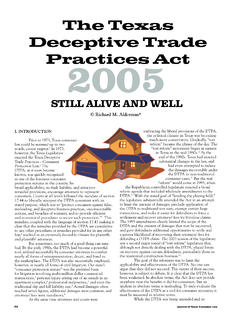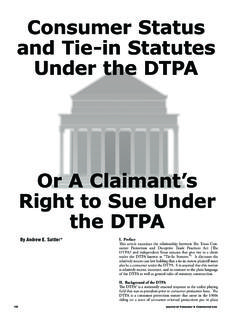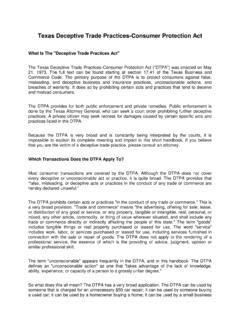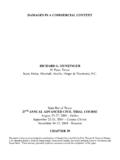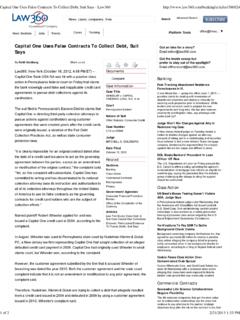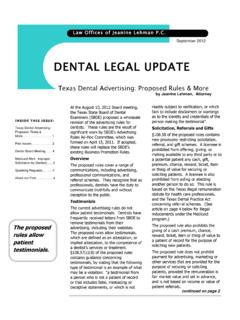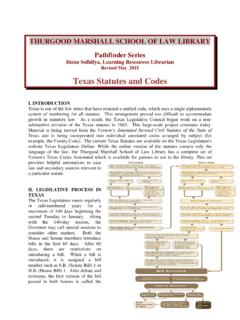Transcription of THE TEXAS RESIDENTIAL CONSTRUCTION …
1 1 THE TEXAS RESIDENTIALCONSTRUCTION LIABILITY ACT: AN OVERVIEWE lliott S. CappuccioPulman, Bresnahan & Pullen, LLP6919 Blanco RoadSan Antonio, TEXAS 78216 Tel. (210) 222-9494, ext. 104 Fax (210) 20, 2004 Houston, TexasThe first case was Trimble v. Itz, 898 370 (Tex. App. - San Antonio 1995, writ denied).1 See , Bruce v. Jim Walters Homes, Inc., 943 121 (Tex. App. - San Antonio 1997, writ denied),2In re Kimball Hill Homes TEXAS , Inc., 969 522 (Tex. App. - Houston [14] Dist. 1998), and Perry Homes , 33 376 (Tex. App. - Ft. Worth 2000, pet. denied).2I. INTRODUCTIONIn the 1980's the CONSTRUCTION industry in TEXAS sensed that it was under attack. Homeownersand plaintiffs lawyers were making frequent use of the Deceptive Trade Practices Act, Tex. Bus. &Comm. Code et seq. ( DTPA ) to satisfy claims arising out of CONSTRUCTION defects. Inresponse, the CONSTRUCTION industry launched a well organized lobbying campaign. Among otherthings, the builders wanted an opportunity to cure any alleged defects before litigation, and theywanted to be free of the DTPA s treble damages.
2 As TEXAS State Senator John Montford (the bill soriginal sponsor) stated during one legislative hearing, [t]he present Deceptive Trade Practices Actdoes not allow the builder to inspect or attempt to repair alleged CONSTRUCTION defects even thoughthe losses of both the builder and the owner can often be minimized if the builder is allowed topromptly inspect and repair the damage. In 1989, the homebuilders won and the TEXAS Legislature enacted RCLA. As with moststatutes, RCLA created more questions than it answered. Surprisingly, however, in the first eightyears after RCLA s enactment, only one RCLA opinion was published and trial courts were makinga variety of inconsistent rulings. Then, beginning around 1997 and continuing through 2003, the1 Courts of Appeals issued a number of significant decisions interpreting RCLA. For the first time,2practitioners and homebuilders alike began to acquire some clarity concerning the application ofSection (a) of the TRCCA defines CONSTRUCTION defect as: the failure of the design, CONSTRUCTION ,3or repair of a home, an alteration of or a repair, addition, or improvement to an existing home, or an appurtenance toa home to meet the applicable warranty and building and performance standards during the applicable warrantyperiod; and any physical damage to the home, an appurtenance to the home, or real property on which the home orappurtenance is affixed that is proximately caused by that failure.
3 3 RCLA in litigation. That was, of course, until September 1, 2003, when the Legislature s mostrecent amendments to RCLA took effect, along with the completely new TEXAS ResidentialConstruction Commission Act, Tex. Prop. Code , et seq. ( TRCCA ). At this stage, it is impossible to predict how courts will apply existing RCLA precedent tothe new amendments and the TRCCA. However, it is probably a safe bet that it will take anothersix or seven years before many of the questions we have today will be answered. Whether apractitioner and his or her client come out on the winning side of that question will depend to a largeextent on how familiar they are with the basic RCLA requirements and the new APPLICATION OF RCLAS ection sets forth the scope of RCLA as follows: [t]his chapter applies to (1) anyaction to recover damages or other relief arising from a CONSTRUCTION defect, except a claim forpersonal injury, survival, or wrongful death or for damage to goods; and (2) any subsequentpurchaser of a residence who files a claim against a contractor.
4 Thus, the first question that arisesis - what constitutes a construct defect under RCLA? In Section (4), CONSTRUCTION defect is defined as the meaning assigned by Section of the TRCCA, for an action to which theTRCCA applies, but for any other action it is defined as: 3a matter concerning the design, CONSTRUCTION , or repair of a new residence, of analteration of or repair or addition to an existing residence, or of an appurtenance toa residence, on which a person has a complaint against a contractor. The term mayIt is also important to remember that RCLA only applies to RESIDENTIAL CONSTRUCTION . It does not apply to4commercial RCLA Section (f)54include any physical damage to the residence, any appurtenance, or the real propertyon which the residence and appurtenance are affixed proximately caused by aconstruction is clear that RCLA applies in cases where a RESIDENTIAL homeowner has sustained damagesresulting from a CONSTRUCTION defect.
5 However, it is still not completely clear whether RCLA4applies in cases where a RESIDENTIAL homeowner has a claim against a contractor but the damagesarise from what could be a non- CONSTRUCTION related component. For instance, a homeowner mighthave a claim against a contractor for selecting a faulty site (resulting in excess soil erosion or waterdamage). In such a case, one might argue that the damages result from negligent site selection andnot a CONSTRUCTION defect. with the DTPARCLA does not create a cause of action in and of itself. See Tex. Prop. Code must still use the DTPA and other common law causes of action in order to state a , Section (b) states that [t]o the extent of conflict between this chapter and any otherlaw, including the Deceptive Trade Practices-Consumer Protection Act .. or a common law causeof action, this chapter prevails. Thus, RCLA became the first statutory exemption from the speaking, RCLA should only conflict with the DTPA and common law causes ofaction if a contractor complies with its duty to timely respond to pre-suit notice.
6 The only RCLA5provisions that constitute an actual conflict with the DTPA are: (1) Section (a)(1) whichRCLA also imposes a higher causation standard than that required under the DTPA. While the DTPA only6requires proof of producing cause, RCLA Section requires proof of proximate cause, which of courserequires evidence that the damages were foreseeable. As a practical matter, the scope of the RCCA is so broad that there will be very few disputes between7homeowners and builders that are not subject to the RCCA. For example, looking at the RCCA exceptions, one suchdispute that might be subject to RCLA and not the RCCA is a claim for an interior remodeling project that costs lessthan $20, 5provides five specific defenses not enumerated under the DTPA; (2) Section (e) which limitsthe damages of a claimant who unreasonably rejects an offer to the cost of repairs, plus attorneys fees prior to the rejection; (3) Section (g) which limits categories of damages thathomeowners may recover when the homeowner and contractor both comply with Section (a)and (b).
7 As a result, if a contractor timely complies with Section (b), these provisions willtrump conflicting provisions in the DTPA. Thus, it cannot be over-emphasized, if a contractor hopesto avail itself of the benefits contained in RCLA, it must first comply with its pre-suit Requirements Since the effective date of the TRCCA, a homeowner does not have to provide separateRCLA notice if he or she has already completed the TRCCA dispute resolution process. For claimsnot subjected to the TRCCA dispute resolution process, the standard RCLA notice provisions to Section (a), at least 60 days before a homeowner files suit against acontractor to recover damages or other relief arising from a CONSTRUCTION defect, he must providenotice of the claim to the contractor by certified mail, return receipt requested, at the builder s lastknown address (assuming the claim is not subject to the new TRCCA). The notice must also specifyTex. Prop. Code, Section (a).
8 In reasonable detail the CONSTRUCTION defects that are the subject of the complaint. It should be8remembered that RCLA notice does not substitute for notice under the DTPA. As a matter ofpractice, it is usually a good idea to include language in a RCLA notice letter that will also satisfythe notice requirements under the requested by the builder, the homeowner must also provide .. any evidence that depictsthe nature and cause of the defect and the nature and extent of repairs necessary to remedy the defect,including expert reports, photographs, and videotapes, if that evidence would be discoverable underRule 192 of the TEXAS Rules of Civil Procedure. After the builder receives notice of a9homeowner s claim, it has 35 days to inspect the property that is the subject of the dispute in order to determine the nature and cause of the defect and the nature and extent of repairs necessary toremedy the defect. The builder is also permitted to document the alleged defects through10photographs and videotape.
9 Section (c) states that if compliance with the RCLA notice provision is impracticable because the statute of limitations will expire during the notice period, thencompliance is not required. However, the petition must specify in reasonable detail eachconstruction defect that is the subject of the dispute. The contractor then has 75 days after servicein which to request an opportunity to inspect the property and the action may be abated during thistime period. Tex. Prop. Code, Section (b). Prop. Code, Section (b)(1) and (2).137 Prior to the 2003 amendments, if a plaintiff failed to comply with the RCLA noticeprovisions for a reason other than an impending statute of limitations deadline, the courts generallyheld that the appropriate remedy was abatement. Now, however, Section (c) provides that thecourt must dismiss the action. of SettlementIf the builder plans on making an offer of settlement to the homeowner (assuming theTRCCA does not apply), it must do so within 45 days of receiving the homeowner s notice offer must be sent by certified mail to the homeowner or the homeowner s attorney.
10 The11settlement offer may include: (1) a proposal for the builder to repair the defect identified in thenotice; (2) a proposal to have an independent contractor repair the identified defect, partially ortotally, at the builder s expense or at a reduced rate; and/or (3) a monetary settlement offer. If thecontractor offers to undertake the repairs, the offer must describe in reasonable detail the kind ofrepairs which will be made. 12 Prior to the recent amendments, a builder only had one opportunity to make a reasonableoffer of settlement, or it risked losing the defensive protections afforded by RCLA. Now, thebuilder has the ability to make a supplemental offer. If the homeowner does not believe that thebuilder s offer is reasonable, the homeowner must, within 25 days of receipt of the offer, advise thebuilder in writing and in reasonable detail the reasons why the offer is unreasonable. Then, Tex. Prop. Code, Section (b).15 Tex. Prop. Code, Section (b).168later than 10 days after the builder receives the homeowner s rejection, it may make a supplementalwritten offer of settlement.
